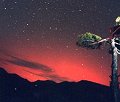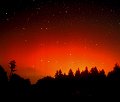|
Summary: A coronal
mass ejection
that billowed away from the Sun on Monday, Sept. 24th, struck
Earth's magnetosphere around 2100 UT on Tuesday, Sept. 25th.
The impact at first seemed to herald widespread auroras. Instead,
it triggered only a moderate (G2-class) geomagnetic storm with
bright Northern Lights confined to magnetic latitudes greater than ~55 degrees
(e.g., Northern Europe, Alaska,
Canada, and the northern tier of US states).
Unless
otherwise stated, all images are copyrighted by the photographers.
|
|
Photographer, Location |
Images |
Comments |
 |
Tom Eklund,
Valkeakoski, Finland
Sept. 25 |
#1,
#2, #3,
#4, #5,
#6, #7,
#8, more |
Photo details: Kodak EliteChrome 100 film, 28mm
f/2.0 lens, 15 to 30 sec exp. |
 |
Lyndon Anderson,
near Steele, North Dakota
Sept. 25 |
#1,
#2, #3,
#4, more |
L. Anderson: "The sky was a diffuse glow
to the north, with very few features in part because of bright
moonlight. The images reveal considerably more color than I could
see with my unaided eye." |
 |
Michel
Benvenuto, Nice, France
Sept. 25-26 |
#1,
#2, #3,
more |
M. Benvenuto: "As soon as we got the aurora
alerts we decided to go where we had already seen two other auroras
in July 2000 and March 2001. This aurora was the most diffuse
one we have seen so far, the color was greyish-red to the naked
eye." Photo details: 17mm f/3.5 lens on Fuji 800 print film,
1-2 min exp. |
 |
Ulrich Beinert,
central Germany (geomagnetic latitude 45 deg.)
Sept. 25-26 |
#1,
#2, #3,
#4, #5,
more |
Although the display was modest, says Ulrich,
"it was only my second aurora -- it was a *really* cool
event.
This was definitely worth almost falling asleep in school this
morning!" Photo details: Canon
EOS 50E with 15mm fisheye lens at f/2.8, 1-5 min exp. |
 |
Michael
Theusner, northern Germany
Sept. 25 |
#1,
#2, #3,
#4 |
M Theusner: "I went [outdoors] with some
friends after the shock front had arrived. But we had to wait
another 2 hours till we finally saw the first rays. The display
only lasted 30 minutes but was quite bright with an intense red
colour." Photo details: 28mm f/2.8 lens, 50 sec exp. on
Kodak E200 slide film |
See
also our Sept. 23, 2001, aurora gallery!
back
to spaceweather.com |




